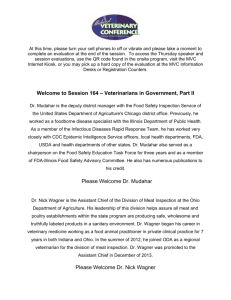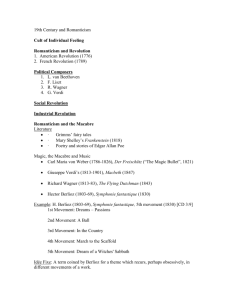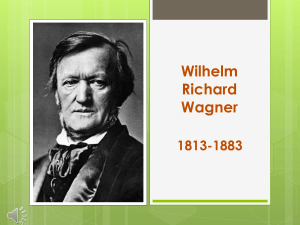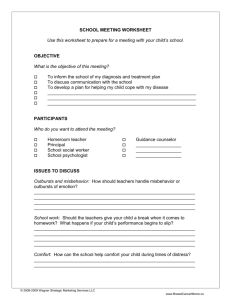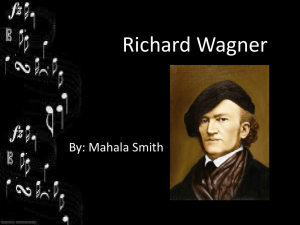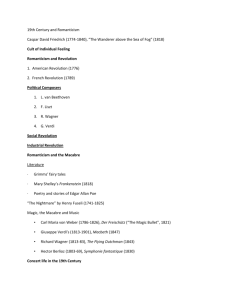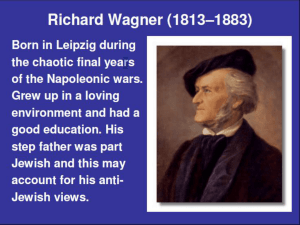Boston Symphony Orchestra concert programs, Season
advertisement
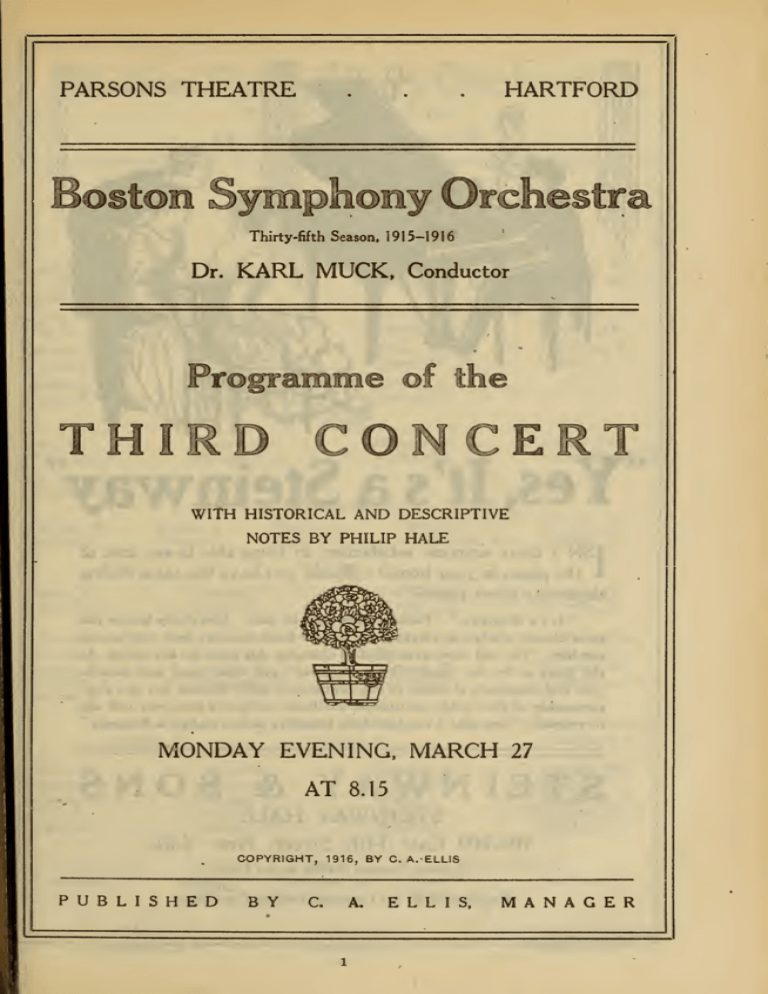
HARTFORD PARSONS THEATRE Thirty-fifth Season. 1915-1916 Dr. KARL MUCK. Conductor WITH HISTORICAL AND DESCRIPTIVE NOTES BY PHILIP HALE MONDAY EVENING, MARCH AT COPYRIGHT, PUBLISHED BY C. 27 8.15 1916, A. BY C. A.-ELLIS ELLIS, MANAGER €i Yes, It's a Steinway" ISN'T there supreme satisfaction in being able to say that of the piano in your home? Would you have the same feeling about any other piano? " Nothing more need be said. Everybody knows you It's a Steinway." have chosen wisely; you have given to your home the very best that money can buy. You will never even think of changing this piano for any other. the years go by the words "It's a Steinway" will you, and thousands of times, as mean more and more you continue to enjoy through life As to the com- panionship of that noble instrument, absolutely without a peer, you will say to yourself: "How glad I am I paid the few extra dollars and got a Steinway." STEINWAY HALL 107-109 East 14th Street, Subway Express Station at the New York Door Represented by the Foremost Dealers Everywhere Thirty-fifth Season, 1915-1916 KARL MUCK, Dr. Conductor PERSONNEL Violins. Koessler, Concert-master. Noack, S. Mahn, F. Hoffmann, Roth, O. Witek, A. M. Theodorowicz, W. Bak, A. Traupe, Tak, E. Ribarsch, A. Baraniecki, A. Habenicht, W. Fiumara, P. Fiedler, B. Berger, Spoor, S. Siilzen, Pinfield, C. Gerardi, A. Gunderson, R. Gewirtz J M. Griinberg, Kurth, R. K. Rissland, J. Schmidt, E. J. Goldstein, H. Sauvlet. H. H. H. Goldstein, S. Fiedler, A. Violas. Ferir, E. Wittmann, F. Werner, H. Gietzen, A. Schwerley, P. Berlin, v.Veen, H. W. Kautzenbach, W. Van Wynbergen, C. W. Blumenau, Violoncellos. v Warnke, H. Keller, J. Malkin, J. Nagel, R. Kunze, M. Barth, C. Nast, L. Belinski, M. Folgmann, E. Steinke, B. Warnke, J. Basses. Gerhardt, G. Agnesy, K. Jaeger, A. Flutes. Maquarre, A. Oboes. Longy, G. Brooke, A. de Mailly, C. Battles, A. Lenom, C. Stanislaus, Seydel, T. Huber, E. Clarinets. Sand, A. Mimart, P. H. English Horn. Vannini, A Bass Clarinet. Stumpf, K. * Mueller, F. Horns. Horns. Wendler, G. Jaenicke, B. Lorbeer, H. Hain, F. Resch, A. Miersch, E. Hess, M. Hiibner, E. Tuba. Harps. Mattersteig, P. Holy, A. Cella, T. Mueller, E. Fuhrmann, M. Contra-Bassoon. Mosbach, J. Trombones. Mann, Belgiorno, S. J. Alloo,M. Nappi, G. Mausebach, A. Kloepfel, L. Kenfield, L. S. Kandler, F. Organ. Librarian. Marshall, J. P. Sauerquell, J. 3 Bassoons. Sadony, P. Trumpets. Heim, G. Tympani. Neumann, Ludwig, O. Schurig, R. Percussion. Zahn, F. Gardner, Burkhardt, H. C Assistant Librarian. Rogers, L. J. '*?/ From Bowstring When string to Pianoforte bow- the melodious twang of a taut first tickled the ear of some skin-clad huntsman of the Stone Age, an immortal musical Through had tradition these its ignoble many thousand birth. years this musical tradition has marvelously developed, from primitive Grecian stringed harp of the from clavichord lyre to the mediaeval minstrels, from harpsichord to spinet, to pianoforte, until finds today it many- its supreme expression in the & •<5&pttl tawi Chickering & Sons, Boston Division of American Piano Co. For Sale by Pierce & Co., 269 Asylum St., Hartford The C. L. 1 1 ^ 9^L ill jL± j>*^ji*JtjiJ HARTFORD PARSONS THEATRE Forty-eighth Concert in Hartford pM© Thirty-fifth Season, 1915-1916 KARL MUCK, Dr. Conductor THIRD CONCERT MONDAY EVENING, MARCH AT 27 8.15 WAGNER PROGRAMME Overture to "The Flying Dutchman" "A Siegfried Idyl" from "The Mastersingers of Nuremberg" (Introduction to Act III.; Dance of the Apprentices; Entrance Selections of the Mastersingers; Homage to Hans Sachs) Prelude to "Lohengrin" The Good Friday Spell from "Parsifal" Overture to "Tannhauser' There will be an intermission of ten minutes between the third and fourth numbers Ovbrturb to "Th^^vino Dutchman* .... Richard Wagner (Born at keipsic, May 22, 1813; died at Venice, February 13, 1883.) ' The overture is two oboes, one four horns, two bassoons, two trumpets, scored for one piccolo, two English horn, two clarinets, flutes, three trombones, one bass tuba, kettledrums, harp, strings. was sketched at Meudon near Paris in September, 1841, and completed and scored at Paris in November of that year. In 1852 Wagner changed the ending. In i860 he wrote another ending for the Paris It concerts. con brio in D minor, 6-4, with an empty fifth, against which horns and bassoons give out the Flying Dutchman motive. There is a stormy development, through which this motive is kept sounding in the brass. There is a hint at the first theme of the main body of the overture, an arpeggio figure in the strings, taken from the accompaniment of one of the movements in the Dutchman's first air in act i. This storm section over, there is an episodic Andante in F major in which wind instruments give out phrases from Senta's ballad of the Flying Dutchman (act ii.). The episode leads directly to the main body of the overture, Allegro con brio in D minor, 6-4, which It opens Allegro begins with the This theme developed at great length with chromatic passages taken from Senta's ballad. The Flying Dutchman theme comes in episodically in the brass from time to time. The subsidiary theme in F major is taken from the sailors' chorus, "Steuermann, lass' die Wacht!" (act iii.). The second theme, the phrase from first theme. is Andante episode, enters f in the worked up brilliantly with fragments Senta's ballad already heard in the full orchestra, F major, and of the first theme. is The Flying Dutchman motive reappears The coda D jf in the A few rising arpeggio measures in the violins lead to the second theme, proclaimed with the trombones. begins in major, 2-2. FOOT GUARD HALL Friday Evening, April 80 RALPH 14, 1916 MALE VOICES L. BALDWIN, Conductor NINTH SEASON SECOND CONCERT Soloist, KATHLEEN PARLOW, Reserved seats and further particulars at Gallup Violinist & Alfred's Music Store force of the orchestra. full The theme is now the Allegro peroration of Senta's ballad, and shape found in worked up with in the it is great energy. * Wagner wrote in "A Communication to my Friends" that before he began to work on the whole opera "The Flying Dutchman" he drafted the words and the music of Senta's ballad. Mr. Ellis says that he wrote this ballad while he was in the thick of the composition "Rienzi." of and itself "Der the is the thematic germ of the whole opera, Wagner felt inclined to call the a dramatic ballad. was performed for the Court Opera House, Dresden, January 2, 1843. fliegende Hollander," opera in three acts, first The ballad should be remembered that it opera The cast time at was as follows: Senta, Mme. Schroeder-Devrient the Dutch; man, Michael Wachter; Daland, Karl Risse; Erik, Reinhold; Mary, Mrs. Wachter; the steersman, Bielezizky. Wagner conducted. The first performance in America was in Italian, "II Vascello Fantasma," at Philadelphia, November 8, 1876, by Mme. Pappenheim's Company. The first performance in Boston was in English at the Globe Theatre, March 14, 1877: Senta, Clara Louise Kellogg; Eric, Joseph Maas; Daland, George A. Conly; the steersman, C. H. Turner; Mary, Marie Lancaster; Vanderdecken, the Dutchman, William Carleton. * * * was undoubtedly due to the dramatic genius Mme. Wilhelmine Schroeder-Devrient (1804-60) that a poor performance was turned the first night into an apparent triumph. It is said that in the part of Senta she surpassed herself in originality; but Wagner wrote to Fischer in 1852 that this performance was a bad one. "When I recall It of AN AMERICAN AUTHOR AN AMERICAN COMPOSER AND TWO AMERICAN MUSIC MOTIVES One of the greatest Words by the great examples of American Music has just been published. American author WALT WHITMAN Music by the well-known American H. T. BURLEIGH Dedicated to and Sung by the American Basso of the Metropolitan Opera Co. Mr. HERBERT WITHERSPOON >., 14 East 43rd Street, NEW YORK ' what an extremely clumsy and wooden 'The Flying Dutcfc man the imaginative Dresden machinist Hanel gave on his magnificerj stage, I am seized even now with an after-attack of rage. Messr; Wachter's and Risse's genial and energetic efforts are also faithfull setting of ' up stored in my memory. Wagner wished Senta ' Northern maid, thoroughly naive He "an altogether robus to be portrayed as apparent sentimentality." wrote: "Only in the heart of an entirely naive girl surrounde by the in her idiosyncrasies of Northern nature could impressions such those of the ballad of the 'Flying Dutchman' and the a picture of th seaman call forth so wondrous strong a bent as the impuls to redeem the doomed: with her this takes the outward form of a pallid active monomania such, indeed, as can only be found in quite naiv We have been told of Norwegian maids of such a force c feeling that death has come upon them through a sudden rigor of th heart. Much in this wise may it go, with the seeming 'morbidness natures. of pallid Senta." Wagner revised the score in "Only where 1852. it was purel; superfluous have I struck out some of the brass, here and there give] a somewhat more human tone, and only thoroughly overhauled th coda of the overture. I remember that it was just this coda whicl always annoyed me at the performances; now I think it will answe We are showing the complete line of UPRIGHTS $500 $600 $750 GRANDS $750 $800 $900 $1000 $1250 STEINWAY PIANOLAS $1250 and $2100 Sole agents for Stein way Pianos in Central Connecticut. 241 ASYLUM STREET, HARTFORD, CT. my to original intention." In another letter he says that he "considerably remodelled the overture (especially the concluding section)." Wagner's contract with Holtei, the manager of the Riga Theatre, expired in the spring of 1839. He was without employment; he was in debt. He determined to go to Paris, but on account of his debts he could not get a passport. His wife went across the border disguised as a lumberman's wife. Wagner himself was hid in an empty sentry-box till he could sneak through the pickets on the frontier line. Composer, wife, and dog met at sailing-vessel bound for London. Pillau, where they embarked on a The voyage was violently stormy, and it lasted three and a half weeks. Once the captain was compelled to put into a Norwegian haven. At Riga Wagner had become acquainted with Heine's version of the Flying Dutchman legend. The voyage, the wild Norwegian scenery, and the tale, as he heard it from the sailors, exerted a still greater influence. In Paris Wagner became acquainted with Heine, and they talked together concerning an opera founded on the legend. The opera was written at Meudon in the spring of 1841. All of it except the overture was completed in seven months. Prager says that the work was composed at the piano. "This incident is of importance, since for several months he had not written a note, and knew not whether he still possessed the power of composing." How a French libretto was made for the production of the work at the Paris Opera, how Wagner suspected treachery and sold the scenario for 500 francs, how "Le Vaisseau Fant6me, paroles de Paul Foucher, musique de Diestch," was produced at the Opera, November there were eleven performances, all this has been 9, 1842, and failed, — — i===:^^^5issggg^ The highly praised LWer-singer are drawn from the from her native Holland to our own America, and including France, Germany, Ireland, etc. This collection is made up of such numbers as have won Mme. Culp's affection as well as proved their acceptability to her enthusiastic audiences, and the volume is of extraordinary interest. A charming Introduction from the singer's own pen and portraits enrich the book. music of favorite songs of many different "The triumphs this lands, of the Singer are reflected in her book."— The Musician m BOSTON cJJOfOUaN EW YORK aO^ffi — programme-books of these concerts. Music was set by Ernst Lebrecht Tschirch (1819-52) to Wagner's libretto about 1852. Clement and Larousse say that this work was performed at Stettin in 1852 Riemann says it was not performed. told in ; * Heine's "Aus den Memoiren des Herrn von Schnabelewopski " was published in 1833. The story of the play seen by Schnabelewopski is in chapter vii. I here use the translation by Mr. Charles Godfrey Leland to : "My old grand-aunt had told me many tales of the sea, which now rose new life. in my memory. I could sit for hours on the deck, recalling the old stories, and when the waves murmured it seemed as if I had heard my grand-aunt's voice. And when I closed my eyes I could see her before me, as she twitched her lips and told the legend of the Flying Dutchman. Once by night I saw a great ship with outspread blood-red sails go by, so that it seemed like a dark giant in a scarlet cloak. Was that the Flying Dutchman ? But in Amsterdam, where I soon arrived," Herr von Schnabelewopski sailed from Hamburg, "I saw the grim Mynheer bodily, and that on the stage. "You certainly know the fable of the Flying Dutchman. It is the story of an enchanted ship which can never arrive in port, and which since time immemorial has been sailing about the sea. When it meets a vessel, some of the unearthly sailors come in a boat and beg the others to take a packet of letters home for them. These letters must be nailed to the mast, else some misfortune will happen to the ship, above all If no Bible be on board, and no horse-shoe nailed to the foremast. The letters are always addressed to people whom no one knows, and who have long been dead, so that some late descendant gets a letter addressed to a far-away great-great-grandmother, who has slept for centuries in her grave. That timber spectre, that grim gray ship, is so called from the captain, a Hollander, who once swore by all the devils that he would get round a certain mountain, whose name has escaped me, in spite of a fearful storm, though he should sail till the Day of Judgment. The devil took him at his word; therefore he must sail . . . — ' ' — HAS BEEN PRESENTED 5 TIMES BY THE METROPOLITAN OPERA COMPANY SINCE ITS SUCCESSFUL PREMIERE JANUARY Its Permanent Place in the 28, 1916 Repertoire seems assured THE VOCAL SCORE, AT TWO DOLLARS, MAY BE OBTAINED FROM YOUR DEALER 10 The devil, in his stupidforever, until set free by a woman's truth.* ity, has no faith in female truth, and allowed the enchanted captain to land once in seven years and get married, and so find opportunities to save his soul. Poor Dutchman! He is often only too glad to be saved from his marriage and his wife-saviour, and get again on board. "The play which I saw in Amsterdam was based on this legend. Another seven years have passed; the poor Hollander is more weary than ever of his endless wandering; he lands, becomes intimate with a Scottish nobleman, to whom he sells diamonds for .a mere song, and, when he hears that his customer has a beautiful daughter, he asks that Next we see the he may wed her. This bargain also is agreed to. Scottish home; the maiden with anxious heart awaits the bridegroom. She often looks with strange sorrow at a great, time-worn picture which hangs in the hall, and represents a handsome man in the NetherlandishSpanish garb. It is an old heirloom, and according to a legend of her grandmother is a true portrait of the Flying Dutchman as he was seen in Scotland a hundred years before, in the time of William of Orange. And with this has come down a warning that the women of the family must be aware of the original. This has naturally enough had the result of deeply impressing the features of the picture on the heart of the romantic girl. Therefore when the man himself makes his appearance, she is startled, but not with fear. He too is moved at beholding the portrait. But when he is informed whose likeness it is, he with tact and easy conversation turns aside all suspicion, jests at the legend, laughs at the Flying Dutchman, the Wandering Jew of the Ocean, and yet, as if moved by the thought, passes into a pathetic mood, depicting how terrible the life must be of one condemned to endure unheard-of tortures on a wild waste of waters, how his body itself is his living coffin, wherein his soul is terribly imprisoned how life and death alike reject him, like an empty cask scornfully thrown by the sea on the shore, and as contemptuously repulsed again into the sea how his agony is as deep as the sea on which he sails his ship without anchor, and his heart without hope. "I believe that these were nearly the words with which the bridegroom ends. The brjde regards him with deep earnestness, casting glances meanwhile at his portrait. It seems as if she had penetrated his secret; and when he afterwards asks: 'Katherine, wilt thou be true to me?' she answers: 'True to death.'" And then the attention of Herr von Schnabelewopski was diverted by an extraordinary amatory adventure. "When I re-entered the theatre, I came in time to see the last scenes — — — * Cape — In the legend as originally told there was no salvation for Vanderdecken^who had tried to make the Good Hope in a storm, and had sworn with horrid oaths that he would weather Table Bay though till the Day of Judgment. P. H. of — he should beat about DEALER IN MUSIC AND MUSIC BOOKS ROOM 25, THE GOODWIN 17 'Phone, Charter 593-3 11 HAYNES STREET 1 ' ' of the play, where the wife of the Flying Dutchman on a high cliff wrings her hands in despair, while her unhappy husband is seen on the deck of his unearthly ship, tossing on the waves. He loves her, and will leave her lest she be lost with him, and he tells her all his dreadful destiny, and the cruel curse which hangs above his head. But she cries aloud, 'I was ever true to thee, and I know how to be ever true unto death "Saying this, she throws herself into the waves, and then the enchantment is ended. The Flying Dutchman is saved, and we see the ghostly ship slowly sinking into the abyss of the sea. "The moral of the play is that women should never marry a Flying Dutchman, while we men may learn from it that one can through women go down and perish under favorable circumstances ! — ! ' Was Heine moved to write his fantastic story by Fitzball's foolish play produced at the Adelphi Theatre, London, December 6,1826? T. P. Cooke played the Dutchman who was in league with a female devil and wished a wife only to swell the number of his victims. He came in blue flames out of the sea and waved a black flag decorated with a skull and cross-bones. George Herbert Bonaparte Rodwell (1800-52) wrote on "original overture" and other music for the play. Mr. Ellis, the translator of Wagner's prose works, regards it as extremely improbable that Heine saw this play. But in 1827 there was a Flying Dutchman at Astley's, and one at Islington, and billboards showed the Dutchman on a cliff. PARSONS THEATRE - - HARTFORD - 1916-1917 Dr. KARL MUCK, Conductor THREE CONCERTS Monday Evening, November 13 Monday Evening, December Monday 12 1 Evening, March 26 'A Siegfried Idyl" (Born at Leipsic, . . . May Richard Wagner , 22, 1813; died at Venice, February 13, 1883.) Cosima Liszt, daughter of Franz Liszt and the Countess d'Agoult, was born at Bellagio, Italy, on Christmas Day, 1837. She was married They were divorced to Hans von Biilow at Berlin^ August 18, 1857. , in the fall of 1869. Richard Wagner married Minna Planer, November 24, 1836, at Konigsberg. They separated in August, 186 1, and she died at Dresden, January 25, 1866. Wagner and Cosima at Lucerne, August 25, is full June November wrote, house, too, Siegfried 1870. at Triebschen, near Lucerne, Wagner von Biilow, were married Wagner, their son, was born Liszt, divorced wife of 11, 1869. 6, 1870, to Ferdinand Prager: of children, the children of my wife, "My but besides there blooms for me a splendid son, strong and beautiful, whom I dare Siegfried Richard Wagner. Now think what I must feel, that at last has fallen to my share. I am fifty-seven years old." month he wrote to Prager: "My son My son! Oh, what that says to me!" 25th of the Richard. is On call this the Helferich Siegfried But these were not the first references to the son. In a letter written to Mrs. Wille, June 25, 1870, Wagner wrote: "Certainly we shall come, for you are to be the first to whom we shall present ourselves as man Incorporated Twenty-sixth Season, 1915 BOARD OF MANAGERS Mrs. J. P. ANDREWS Miss ANDREWS Mrs. T. B. BEACH Miss CLARK Mrs. ANSEL G. COOK Mrs. JULIUS GAY Mrs. W. L. GOODWIN Miss LUCY A. PERKINS Mrs. S. B. ST. JOHN Mrs. C. D. WARNER Mrs. A. A. WELCH Miss VILLA W. WHITE MARY FACULTY: WILLIAM L. WHITNEY (Boston), Voice Production, Interpretation EDWARD NOYES (Boston), Piano Department LILLIAN BISSELL, FLORENCE A. ATKINS, HAROLD WEBSTER, ELLIOT S. FOOTE, FRANZ MILCKE, LAURA WHEELER ROSS, ARTHUR PRIEST, WALDO S. PRATT, Lecturer in Musical History Violin Organ APPLY TO HARTFORD SCHOOL OF MUSIC, 8 Spring Street, Hartford, Conn. 13 — and — She has defied all disapprobation and taken upon herself every condemnation. She has borne to me a wonderfully beautiful and vigorous boy, whom I could boldly call 'Siegfried': he is now growing, together with my work, and gives me a new, long life, which wife. at last has attained a meaning. Thus we get along without the world, from which we have retired entirely. But now listen; you will, I trust, approve of the sentiment which leads^us to postpone our visit until I can introduce to you the mother of my son as my wedded wife." (Finck's Wagner, vol. ii, p. 246.) The "Siegfried Idyl" was a birthday gift to the composer's wife. It was composed in November, 1870, at Triebschen, near Lucerne. According to Hans Richter's story, he received the manuscript score on December 4, 1870. Wagner gave a remarkably fine copy to his wife. Richter wrote out immediately the parts, and then went to Zurich, where, with the help of Oskar Kahl, concert-master of the City orchestra, he engaged musicians. The first rehearsal was on .* . December 21, . 1870, in the foyer of the old theatre in Zurich. was born while the composition of the music-drama "Siegfried" was in progress. The themes in the Idyl were taken from the music-drama, all save one,: a folk-song, "Schlaf, mein Kind, schlaf ein"; but the development of the themes was new. Siegfried — Wagner wrote a dedication to his wife : Es war Dein opfermutig hehrer Wille Der meinem Werk die Werdestatte fand, Von Dir geweint zu weltentruckter Stille, Wo nun es wuchs und kraftig uns enstand, Die Heldenwelt uns zaubernd zum Idylle, Uraltes Fern zu trautem Heimatland. Erscholl ein Ruf da froh in meine Weisen: "Ein Sohn ist da!" Der musste Siegfried heissen. Fur ihn und Dich durft' ich in Tonen danken, Wie gab' es Liebesthaten hold'ren Lohn? Sie hegten wir in uns'res Heimes Schranken, Die stille Freude, die hier ward zum Ton Die sich uns treu erwiesen ohne Wanken, So Siegfried hold, wie freundlich uns'rem Sohn, Mit Deiner Huld sei ihnen jetzt erschlossen, Was sonst als tonend Gliick wir still genossen. GOLD MEDAL OF HONOR awarded HARP AT PANAMA-PACIFIC EXPOSITION Wurlitzer Harps are used by the world's foremost harpists. -Complete line may be seen at my studio. 236 BAY STATE ROAD :: 14 :: :: :: :: BOSTON — Mr. Louis C. Elson has Englished poem this freely in verse : Thy sacrifices have shed blessings o'er me, And to my work have given noble aim, And in the hour of conflict they upbore me, Until my labor reached a sturdy frame, Oft in the land of legends we were dreaming, Those legends which contain the Teuton's fame, Until a son upon our lives was beaming, Siegfried must be our youthful hero's name. For him and thee in tones I now am praising; What thanks for deeds of love could better be? Within our souls the grateful song upraising Which in this music I have now set free? And in the cadence I have held, united, Siegfried, our dearly cherished son, and thee; And all the harmonies I now am bringing But speak the thought which in my heart is ringing. The is composition, which first bore the title " Triebschener Idyll," scored for flute, oboe, two clarinets, trumpet, two horns, bassoon, and strings. III., Dance of the Apprentices, Procession of the Master Singers, and Song of Greeting to Hans Sachs, from Richard Wagner "-The Master Singers of Nuremberg" (Born at Leipsic, May 22, 1813; died at Venice, February 13, 1883.) Prelude to Act . . "Die Meistersinger von Niirnberg," a musical comedy in three and music by Wagner, was performed for the first time at the Royal Court Theatre, Munich, June 21, 1868. Hans Sachs, Betz; Pogner, Bausewem; Beckmesser, Holzel; David, Schlosser; Walther, Nachbaur; Eva, Mathilde Mallinger; Magdalene, Mme. Diez. Hans von Biilow conducted. The first performance in the United States was at the Metropolitan Opera House, New York, January 4, 1886. Hans Sachs, Fischer; Pogner, Staudigl; Beckmesser, Kemlitz; David, Kramer; Walther, Stritt; Eva, Auguste Krauss (Mrs. Seidl); Magdalene, Marianne Brandt. Anton Seidl conducted. The idea of the opera occurred to Wagner at Marienbad in 1845. The acts, text Commonwealth Avenue, near Massachusetts Avenue Surface Lines and Subway Station A Some globe The high-class hotel with moderate rates trotters have been good enough to say that the attractive and home-like hotels in the world. of the most Hluatrated booklet of the Hotel will be mailed on request. 15 S. M. Puritan Costello. is one Manager a was completed at Paris in 1861. In 1862 he worked on the music. The score was completed on October 21, 1867. The selections are scored for piccolo, two flutes, two oboes, two clarinets, two bassoons, four horns, three trumpets, three trombones, bass tuba, kettledrums, triangle, cymbals, Glockenspiel, and the usual libretto strings. The Prelude to act begins with a slow passage for iii. 'cellos — theme associated with Sachs in the opera. The second phrase is treated in a semi-fugal manner by the strings. This passage, etwas gedehnt (Un poco largo), G minor, 4-4, is followed by a solemn passage G song of greeting to Sachs, sung by the crowd as he appears to judge in the singing contest at the end of the This choral is played in harmony by horns, bassoons, trumpets, act. trombones, and tuba. The strings interrupt it with dreamy measures based on phrases from Sachs's cobbler song and the Sachs motive. Flutes and clarinets are added. The violins remember Walther's Spring Song in the first act. The second half of the choral is given out Then the orchestra develops the Sachs motive, by wind instruments. and at the end of a diminuendo there is a reference to the cobbler's song. Dance of the Apprentices, act iii., scene 5, B-flat major, moderate waltz time (the meadow, on the banks of the Pegnitz where the singing contest will take place) Trills for wood- wind, then for violins and violas against ascending scale passages lead to the St. John's Day motive (violins with a background of trills for wood- wind). Then comes the Apprentice's Waltz (handler). It is a series of seven-measure phrases. This theme is, worked with varied instrumentation, and it alternates with a broader theme. A climax is followed by a return of trills which lead to a passage, Moderato, C major, 4-4, in which the in major. , It is the choral . theme ment. of the is made the subject for developinto line for the procession and the full (Ihe familiar theme begins the Prelude Master Singers' March The Master Singers fall orchestra plays the march. to the opera.) short and lively passage during which Sachs is recognized by the throng leads to a repetition of the choral greeting Ihis is here followed by a to him by the full orchestra (G major). return of the last fourteen measures of the Prelude to the act with three closing measures added by way of final cadence. A Prelude) to the: Opera "Lohejngrin" (Born at Leipsic, May 22, 1813; Richard Wagner died at Venice, February 13, 1883.) "Lohengrin," an opera in three acts, was performed for the first time at the Court Theatre, Weimar, August 28, 1850. The cast was King Henry, as follows: Lohengrin, Beck; Telramund, Milde; Hofer; the Herald, Patsch; Ortrud, Miss Fastlinger; Elsa, Miss Agthe. Liszt conducted. It was at Marienbad in the summer of 1845 that Wagner laid out the scheme of "Lohengrin." He wrote the libretto in the following winter, and conceived some of the melodic ideas. He began the actual composition of the opera with the narrative of Lohengrin, "because the monologue contained the most significant musical germs in the whole 16 In the original version, after the words "and Lohengrin my name," the orchestra intoned the Grail theme, the chorus treated the theme in the same manner as in the first act when the knight appears, and then the recitation continued in a manner analogous to first section. The third act of "Lohengrin" was composed at Grossgraufen between September 9, 1846, and March 5, 1847; the first act between May 12 and June 8, 1847; the second act between June 18 and August 2 of the same year. The prelude was completed on August 28, 1847, and the instrumentation was made during the following winter and spring. The score was not published for several years, to quote from Mr. W. J. Henderson's "Richard Wagner" (New York, 1901), "because Meser, who had printed the previous works of the composer, had lost money by the ventures. Breitkopf and artel subsequently secured the score at a small price, not because they were niggardly in offering, but because Wagner's works had no large market value at the time, and he was anxious to sell, being in his chronic condition of score." — — H embarrassment." performance of "Lohengrin" (in German) in the United States was at the Stadt Theatre, New York, April 3, 1871. Adolf Neuendorff conducted. The Prelude is the development and working-out of the Sangreal motive. Berlioz described the composition as a gradual crescendo leading to a shorter decrescendo. "Like the hero's career in the opera," says Mr. Ap thorp, "it begins, as it were, in the clouds, then gradually descends farther and farther until it embraces all the lowIts est tones of the orchestra, and then returns to the clouds again. single theme is developed in free polyphony by various successive groups of instruments, each of which groups proceeds with free counterthematic work as the next group enters with the theme. First we have the violins piano in their higher register; then come the flutes, oboes, and clarinets; then the violas, 'cellos, horns, bassoons, and double basses; lastly the trumpets, trombones, and tuba fortissimo; then comes the decrescendo, ending pianissimo in the high violins financial The and first flutes." The Prelude scored for three flutes, two oboes, English horn, two clarinets, bass clarinet, three bassoons, four horns, three trumpets, three trombones, bass tuba, a set of three kettledrums, cymbals, four solo violins, and the usual strings. is For hoarseness, coughs, bronchial and asthmatic troubles use B R O CAMPHORATED SAPONACEOUS CE will An old and reliable remedy for throat troubles caused by cold or use of the voice. Free from opiates in any form. Sold everywhere in boxes— never in bulk Prices, 10c., 25c, 50c., JOHN I. BROWN & keep the teeth and gums in good condition. Leaves a particularly clean and pleasant feeling in the mouth. For sale by druggists and dealers in toilet articles, or sent on receipt of price. 25c. Sample sent free on request. Manf'd by and $1.00 JOHN I. BROWN & SON, Boston Curtis & Brown Mfg. Co., Ltd., New York, N.Y. SON, BOSTON, MASS. 17 . "Good Friday Speu,," from (Born at Leipsic, May " Parsifal" 22, 1813; . . . Richard Wagner died at Venice, February 13, 1883.) "a stage-consecration festival play" in three acts, book and music by Richard Wagner, was first performed at Bayreuth for the patrons, July 26, 1882. The first public performance was on July Materna was Kundry; Winkelmann, Parsifal; Scaria, 30, 1882. Gurnemanz, in the original cast. Levi conducted. The first performance in the United States was at the Metropolitan Opera House (Mr. Heinrich Conried, director), New York, December Mr. Alfred Hertz conducted. The cast was as follows: 24, 1903. Kundry, Milka Ternina; Parsifal, Alois Burgstaller; Amfortas, Anton Van Rooy; Gurnemanz, Robert Blass; Titurel, Marcel Journet Kling"Parsifal," ; Otto Goritz. The first performance in Boston was in English the first performance in English on any stage at the Tremont Theatre by Mr. Henry W. Savage's company, October 17, 1904. Mr. Walter H. Rothwell sor, — — Kundry, Mme. Kirkby Lunn; Parsifal, Alois Pennarini; Amfortas, Johannes Bischoff; Gurnemanz, Putnam Griswold; Titurel, Robert K. Parker; Klingsor, Homer conducted. The cast was as follows: Lind. performance in German in Boston was on March 7, 1905, by the Metropolitan Opera House Company of New York. Mr. Hertz conducted. The cast was as follows Kundry, Mme. Nordica; Parsifal, Alois Burgstaller; Amfortas, Anton Van Rooy; Gurnemanz, Robert Blass; Titurel, Marcel Journet; Klingsor, Otto The first at the Boston Theatre : Goritz. The (Good Friday at the end of scene 1 Gurnemanz, now a very old man, is living as a hermit in of act iii. a rude hut at the edge of a forest. The scene represents a meadow dotted with flowers. Gurnemanz comes out of the hut at the left, for he has heard a groaning, as from a beast in pain. He finds Kundry half -dead, in lethargic sleep. He awakens her, and she can say only: "To serve! To serve!" She goes for water, and, while she is kneeling by a spring, she sees some one coming by a forest road. 'Tis a knight clad in black armor, with visor down, who holds the sacred spear and a buckler. He says nothing at first, not even in reply to the old man, Then he plants until the latter reminds him that it is Good Friday. the spear in the ground, raises his visor, takes off the helmet, and prays before the lance. Gurnemanz recognizes the fool whom he had rudely dismissed from the temple. Parsifal knows him, and tells him vaguely of his wanderings. Now he is in search of a lamentation that he once heard without understanding. There is sore need of his presence, Gurnemanz replies, for Titurel has died, Amfortas will not perform the duties of Grail-warder, and the holy vessel is no more revealed. "And it is I," cries Parsifal, "who caused all this distress." He is about to faint, but Gurnemanz supports him and guides him Charfreitagszauber 18 Spell) is spring.' Kundry washes the feet of Parsifal, anoints them with precious oil, and wipes them with the hairs of her head. Gurnemanz puts water on his forehead, blesses him, and salutes him king. Parsifal baptizes Kundry, and then he looks with delight at the forest toward the and the meadow. (We use here the translation of Wagner's text that has been pubprogramme books of these concerts.) lished in the Parsifal,: How fair the meadow seems to-day! I have, indeed, met with prodigious flowers, that wound themselves yearningly round me up to my head; yet never have I seen stalks, blossoms, and flowers so tender and delicate, nor have they had so childlike-sweet a perfume, nor spoken so lovingly to me. Gurnemanz: That is Good Friday's spell, sir. Parsifal: O woe, the highest day of grief! Now should, meseems, all that blooms, that breathes, that lives and lives again, do nought but mourn, alas! and weep? Gurnemanz: Thou seest, it is not so. 'Tis the sinner's repentant tears that have to-day besprinkled field and meadow with holy dew; 'tis this has made them so to thrive. Now all creation rejoices on the Saviour's sweet traces, and vows its prayer to Him. Himself upon the cross it cannot behold; so it looks up to redeemed Man; he feels himself free from the terror and horror of sin, clean and whole through God's love-sacrifice. Now, the stalks and flowers in the meadow notice this, that the foot of Alan does not tread them down to-day, but that, as God with heavenly patience, took compassion on and suffered for him, so, too, does Man, with pious graciousness, spare them with gentle step. Therefore does all creation that now blooms, and soon shall die, give thanks, while Nature, freed from sin, to-day doth earn her day of innocence. Kundry has slowly raised her head, and, with face bathed in tears, looks at Parsifal. "You weep," says Parsifal. "See, the meadow smiles." He kisses her on the forehead, and thus the first act of his mission as redeemer is accomplished. And now bells sound mournfully from afar. Gurnemanz and Kundry robe Parsifal, and they set out for Montsalvat. When Gurnemanz blesses Parsifal and salutes him king, trumpets, horns, and trombones play the Parsifal-motive, which is developed into an imposing period, and ends with the Grail theme intoned by the whole orchestra fortissimo. series of chords leads to the motives of Baptism and Faith. When Parsifal turns slowly toward the meadow, a hymn of tender thanksgiving arises from the orchestra. The melody is played by oboe and flute, while muted strings sustain. In the development of this theme occur several figures and motives, Kundry's sigh, the Holy Supper, the spear, the Grail harmonies, the complaint of the flowergirls, which are all finally absorbed in the Good Friday melody. This pastoral is interrupted suddenly by the distant sound of bells. A — BOUND COPIES of the PROGRAMME BOOKS Containing Mr. Philip Hale's analytical and descriptive notes on all works performed during the season ("musically speaking, the greatest art annual of to-day." W. J. Henderson, New York Sun), may be obtained by addressing A. ELLIS PRICE. $3 50 SYMPHONY HALL — C 19 OLD in in experience and reliability methods and appliances and everything kept "up to date" Packages called for and delivered in Boston and suburbs or by mail or express Americas Greatest DYERS CLEANSERS LAUNDERERS Telephone 526 Charter Shops in Cambridge Brook line Watertown Waltham Maiden Roxbury Lynn Salem Lowell Fall River Boston New York Springfield Portland Providence Waterbury New Haven Albany Washington Newport Bridgeport Philadelphia Worcester Fitchburg Telephones in all shops Parcels called for and delivered "YOU CAN RELY ON LEWANDOS" 20 Beethoven Symphony No. 7, in A major, Op. 92 I. November 15 Brahms Symphony No. 4, in E minor, Op. 98 II. December 13 Bruch "Ave Maria," from "The Cross of Fire," A Dramatic Cantata, Op. 52 Florence HinklE November 15 II. by December 13 II. December 13 I. November 15 I. November 15 I. Dukas "L'Apprenti Sorcier" ("The Sorcerer's Apprentice") Goethe) (after a ballad MacDowell Concerto for Pianoforte, No. 2, in D minor, Op. 23 Laeta Hartley Mozart Aria, "Voi, che sapete," from "The Marriage of Figaro" Florence Hinkle RlMSKY-KORSAKOEE Caprice on Spanish Themes, Op. 34 SmeTana "Vysehrad," Symphonic Poem, No. Country") 1 of the Cycle "Ma Vlast" ("My II. December 13 November 15 March 27 Weber Overture to the Opera "Oberon" I. Wagner Overture, "The Flying Dutchman" A Siegfried Idyl Selections from "The Mastersingers of Prelude to "Lohengrin" "Good Friday Spell," from "Parsifal" Overture to "Tannhauser" 21 Nuremberg" III. Overture to the Opera "Tannhauser" (Born at Leipsic, May . 22, 1813; died at Venice, . Richard Wagner . February 13, 1883.) "Tannhauser und der Sangerkrieg auf Wartburg," romantic opera book and music by Richard Wagner, was first performed at the Royal Opera House in Dresden, under the direction of the comThe cast was as follows: Hermann, poser, on October 19, 1845. Dettmer; Tannhauser, Tichatschek; Wolfram, Mitterwurzer; Walther, Schloss; Biterolf, Wachter; Heinrich, Gurth Reimar, Risse; Elisabeth, Johanna Wagner; Venus, Schroeder-Devrient; a young shepherd, Miss in three acts, ; Thiele. The New first performance in the United States was at the Stadt Theatre, and the cast was as follows: Hermann, Graff; Tannhauser, Pickaneser; Wolfram, Lehmann; Walther, Lotti Biterolf, York, April 4, 1859, ; Urchs; Heinrich, Bolten; Reimar, Brandt; Elisabeth, Mrs. Siedenburg; Venus, Mrs. Pickaneser. Carl Bergmann conducted. The New York Evening Post said that the part of Tannhauser was beyond the abilities of Mr. Pickaneser: "The lady singers have but little to do in the opera, and did that The coda with a new of the little respectably." of the overture was cut version of the first work Op£ra, Paris, in a translation March 13, out, and the overture was connected scene of the opera for the performance by Charles Nuitter 1861. Some into French at the consider therefore the overture in its original shape as a concert overture, one no longer authentically connected with the opera. The overture is scored for piccolo, two flutes, two oboes, two clarinets, two bassoons, four horns, three trumpets, three trombones, bass tuba, kettledrums, cymbals, triangle, tambourine, strings. with a slow introduction, Andante maestoso, E major, 3-4, in which the pilgrims' chorus, "Begltickt darf nun dich, o Heimath, ich schauen," from the third act, is heard, at first played piano by lower wood-wind instruments and horns with the melody in the tromIt begins then sinking to a pianissimo (clarinets and bassoons). They that delight in tagging motives so that there may be no mistake in recognition call the first melody the "Religious Motive" or "The Motive of Faith." The ascending bones against a persistent figure in the violins, TEACHER OF SINGING 610-611 PIERCE BUILDING, COPLEY SQUARE 22 phrase given to the violoncellos is named the "Motive of Contrition," and the persistent violin figure the "Motive The main body oMhe overture, Allegro, of Rejoicing." E major, 4-4, begins even an ascending first before the completion of the pilgrims' song with theme (violas), "the typical motive of the Venus Mountain." "Inside the Horsel here the air is hot; Right little peace one hath for it, God wot; The scented dusty daylight burns the air, And my heart chokes me till I hear it not." The first period of the movement is' taken up wholly with baccha- nalian music from the opening scene in the Venus Mountain; and the motive that answers the ascending typical figure, the motive for violins, flutes, oboes, then oboes and clarinets, is known as the theme This of the bacchanal, "the drunkenness of the Venus Mountain." period is followed by a subsidiary theme in the same key, a passionate figure in the violins against ascending chromatic passages in the 'cellos. The second theme, B major, is Tannhauser's song to Venus, "Dir tone Lob!" The bacchanal music returns, wilder than before. A pianissimo episode follows, in which the clarinet sings the appeal of Venus to Tannhauser, "Geliebter, komm, sieh' dort die Grotte," the typical phrase of the goddess. This episode takes the place of the free The third part begins with the passionate subsidiary theme, fantasia. which leads as before to the second theme, Tannhauser's song, which Again the bacchanalian music, still more frenetic. is now in K major. There is stormy development; the violin figure which accompanied the pilgrims' chant returns, and the coda begins, in which this chant is repeated. The violin figure grows swifter and swifter as the fortisis thundered out by trombones and trumpets to full simo chant harmony in the rest of the orchestra. MUSICAL INSTRUCTION TEACHER OF SINGING 602 Pierce Building Copley Square, BOSTON RECITALS A SPECIALTY ' (Fellow of The American Guild I nstruction in Organ, Harmony, and Piano Address, 140 Boylston Street. Boston, or of Organists) 92 Corey Organist and Choirmaster Park Street Church Road Brookline ' Telephone. 2717-M Brookline 23 MUSICAL INSTRUCTION PIANIST INSTRUCTION Exponent of the Leschetizky School Pupil of Mrs. Thomas Tapper Franklin Cannon, New York Studio HOTEL HEMENWAY Marie Prentner, Theodor Leschetizky, Vienna For appointments, 'Phone Back Bay 3180 TEACHER 372 of SINGING BOYLSTON STREET PIANIST CONCERTS LESSONS Special work in Ensemble playing with Violin and Violoncello, for practice or concert work Refers to Harold Bauer Boston . . Care Richard Newman, Steinert Hall Worcester Tucker Pianoforte School, 1 1 Foster St. VIOLIN INSTRUCTION Has well-known studied with such artists as Mme. CAMILLA URSO. EDUARD HERRMANN, and YSAYE CONCERT VIOLINIST The Hunnewell, 169 Washington Street NEWTON. MASS. Telephone. Newton North Piano Instruction Rafael Joseffy Method Assistant to the late Rafael Joseffy o t j' | ( Mail Address: Carnegie Hall, New York Carnegie Hall Steinway Hall SINGERS— Suzanne Baker Watson, Cora Cross, Nellie Hart, Wulette Kershaw, Gertrude Hutcheson, Ivy Scott, Marion Stanley, Estelle Ward, Mabel Wilbur, Flora Zabefle, Edward Foley, George Gilbert, BEL CANTO Studio 1425 (Successor to Broadway, Anna Miller John Hendricks, Andrew Mack, Dr. Eugene Walton Marshall, Fiske O'Hara, Umberto Sacchetti, Ellis Rhodes, Albert Wallerstedt, and many other singers now before the public in operatic and church work NEW YORK Wood) SOPRANO SOLOIST SOPRANO SOLOIST TEACHER TEACHER OF SINGING STUDIO 609 PIERCE BUILDING Telephone. Back Bay 5145-R. - of SINGING - Lang Studios 24 - 6 Newbury Street
